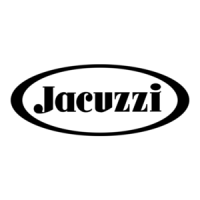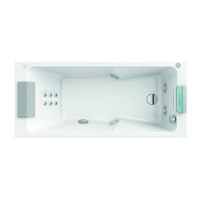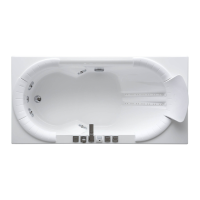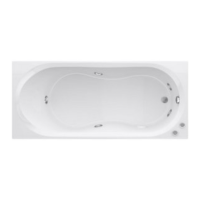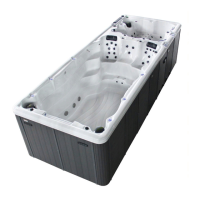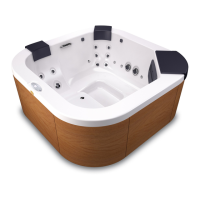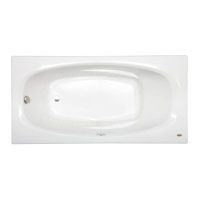30
XClean the cover with a soft brush.
XTo remove all soap residue, rinse with plenty of clean water.
XIn case of heavy incrustation, repeat the operation.
XIf necessary, perform the steps above on the back side as well.
XLet the cover dry. Then place it on its support until it is per-
fectly dry.
Leatherette
XUse a neutral cleaner, then rinse with clean water.
XIf necessary, use a specic product after cleaning to restore
and maintain the material’s shine.
SPECIAL MAINTENANCE
QWinter inactivity
In areas where winter temperatures frequently drop below 0°C,
during periods in which the spa is not used, proceed as follows:
XTurn o the power supply on the main panel.
XCompletely drain the spa via the drain valve, which is to be
left open, and the possible gate valve installed on the auxiliary
drain (if installed; refer to the pre-installation instructions).
The emptying of the spa is not complete; stagnant water on the
seats and bottom of the tub can be eliminated with a sponge, while
water left in the hoses can be sucked out through the hydromassa-
ge and suction intakes, using a liquid-suction pump. It is advisable
to empty the pump as well via the appropriate drain plug.
IMPORTANT
In cold climates, where temperatures drop well below 0°C,
all residual water should be eliminated from the circuit.
XRemove and clean the lter cartridge and store in a dry place.
XCover the spa to keep it clean.
XBefore you use the spa again, refer to the chapter on opera-
ting checks for rst start-up.
XIn areas where temperatures only occasionally drop below 0 °C,
the spa can be left in operation, since it is equipped with an anti-
freeze protection that ensures that a minimum water temperatu-
re is maintained (see the chapter “Setting water temperature”, which
contains paragraphs on maintaining the minimum water temperature
and preventing freezing of water in the pipes - “Smart Winter” mode).
QMaintenance of synthetic wood parts
Synthetic wood panels require little maintenance; use a neutral
detergent when cleaning, rinsing with clean water.
CAUTION
Do not use jets of water to clean panels as they may pen-
etrate into the spa technical compartment and cause
damage to the electrical system.
QMaintenance of natural wood parts
Some of the Jacuzzi® spa covering panels and accessories are
made of natural wood, treated with advanced products which
enhance the natural beauty and ensure protection against atmos-
pheric agents.
The panels and accessories rst receive a coat of stain, to give the
wood an even shade. Then two coats of synthetic oil are applied,
which give the piece a natural and particularly warm appearance.
Cleaning
XMaintenance varies according to the location of the spa and/
or accessories (sheltered from or exposed to the elements).
In any case, you should periodically wash the surfaces with fresh
water and neutral detergent. Then rinse.
Do not use detergents that contain alcohol, scale-removal sub-
stances, ammonia, abrasive products or bleach.
Do not use wax or polish.
Renewal
At least once a year (or less, depending on the conditions the
wood surfaces are exposed to), do the following:
XLightly sand the surface with an abrasive sponge (or sandpa-
per, grain 320). Do not press too hard, especially near protruding
parts (corners and so on).
XRemove all dust. Use a soft-bristled brush to apply a layer of
synthetic oil, rst crosswise and then along the entire height of
the panel.
Do not work in direct sunlight, nor if the temperature is espe-
cially cold.
XIf necessary, remove any excess oil using a microber cloth.
Let dry for about an hour (at 20°C).
Note: tools can be washed with turpentine for subsequent reuse.
If more extensive restoration is require (for example, if the pro-
tective layer has been damaged in depth), you should thorou-
ghly sand the entre surface all the way down to the bare wood.
Apply a coat of stain if there are marked dierences in shades.
Then apply two to three coats of synthetic oil as necessary, fol-
lowing the same method described for the renewal phase.
Note: make sure that, between one coat and the nest, the product
has dried completely. This normally takes 1 to 2 hours at an am-
bient temperature of about 20 °C).
